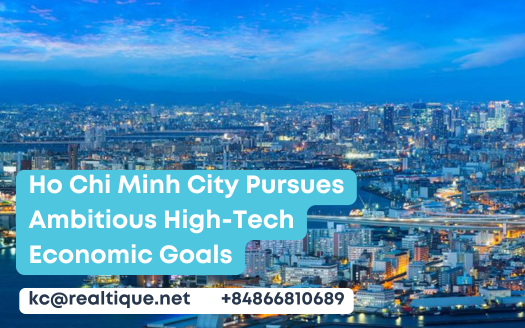Ho Chi Minh City Pursues Ambitious High-Tech Economic Goals
Ho Chi Minh City is strategically targeting a significant increase in the high-tech sector‘s contribution to its Gross Regional Domestic Product, aspiring to reach 40% by 2030. This ambition is highlighted by a strong economic growth rate of 6.46% observed in early 2024 and a commitment to industrial change through modernization and sustainability. As TP HCM maneuvers through the intricacies of global collaboration and workforce development, the implications of these initiatives extend beyond local boundaries, prompting critical questions about the future path of its economy and the challenges that lie ahead.
The ambitious economic goals of Ho Chi Minh City are centered around significantly elevating the contribution of high technology industries to its Gross Regional Domestic Product (GRDP), with a target of reaching 40% by 2030.
Currently, high technology industries account for approximately 23% of GRDP, indicating substantial room for growth. Achieving this target is essential for enhancing economic development and increasing the city’s competitiveness in the region.
In early 2024, Ho Chi Minh City recorded an economic growth rate of 6.46%, the highest since 2020, alongside a 5.6% increase in the industrial production index.
These indicators reflect a positive path and highlight the city’s commitment to nurturing innovation and advancing its high-tech sector as a cornerstone of future economic prosperity.
Ho Chi Minh City's Industrial Transformation Initiatives
Building on the foundation of ambitious economic goals, Ho Chi Minh City is actively pursuing industrial change initiatives aimed at enhancing its technological capabilities.
These initiatives focus on promoting a high-tech industrial environment through several key strategies:
Automation and Smart Factories: Transitioning to advanced manufacturing processes that utilize automation to improve efficiency and productivity.
Green Transformation and Digitalization: Implementing sustainable practices alongside digital technologies to create a resilient industrial sector.
Public-Private Partnerships: Encouraging collaboration between government and industry stakeholders to facilitate technology transfer and improve industrial competencies.
Through these initiatives, Ho Chi Minh City aims to strengthen its position in the competitive environment, driving economic growth while ensuring sustainable development in its industrial base.
Achieving its high-tech economic goals requires Ho Chi Minh City to engage in strong global collaboration and learning. By benchmarking against successful international cities like Osaka and Torino, Ho Chi Minh City can adopt effective industrial growth strategies and sustainable practices.
Knowledge gained from these partnerships will enhance the city’s research and development investments while cultivating a high-quality workforce through targeted training programs. Additionally, adopting international standards in technology and environmental sustainability will guarantee that Ho Chi Minh City remains competitive in the global market.
Strategic alliances will be vital in achieving carbon neutrality by 2050, reinforcing the city’s commitment to sustainable development. Overall, collaborative efforts will serve as a cornerstone in Ho Chi Minh City’s pursuit of high-tech advancements and economic growth.
Labor Productivity and Automation
How can labor productivity be altered through the integration of automation in Ho Chi Minh City’s high-tech strategy?
By embracing automation, Ho Chi Minh City can significantly enhance labor productivity, projecting an increase of 30% over the next decade. This shift not only modernizes workflows but also aligns with sustainability goals.
Key components of this approach include:
- Skill Development: Investing in training programs to equip the workforce with necessary high-tech skills.
- Resource Efficiency: Reducing dependency on natural resources through advanced technological applications.
- Carbon Reduction: Supporting the commitment of global companies to lower carbon emissions, with approximately 70% aiming for a 25% reduction by 2030.
These strategies collectively position Ho Chi Minh City to thrive in a competitive global economy while promoting sustainable growth.
Trade and Economic Integration
Trade and economic integration are essential components of Ho Chi Minh City’s strategy to enhance its global competitiveness and adapt to changing market demands.
The Detailed and Progressive Agreement for Trans-Pacific Partnership (CPTPP) sets high standards that necessitate local adjustments to maintain market relevance.
To thrive, Ho Chi Minh City must align its trade policies with sustainable development principles, ensuring environmental considerations are integrated into economic strategies.
Meeting international trade standards is crucial for securing access to global markets, thus expanding export capabilities, particularly in high-tech sectors.
The city’s focus on enhancing its industrial base through collaboration and innovation will be key in fortifying its position within the global supply chain and tapping into emerging opportunities in the high-tech arena.





